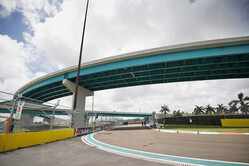


05/05/2022
NEWS STORY
 The men responsible for the design of the Miami circuit explain its challenge, not least the ‘mistake generator' in the final sector.
The men responsible for the design of the Miami circuit explain its challenge, not least the ‘mistake generator' in the final sector.
While much of the F1 world appears to have already gone bat-shit crazy over this weekend's inaugural Miami Grand Prix, fans of a certain vintage are reserving judgement. And who can blame them.
As McLaren explains in its preview of the weekend; "Miami International Autodrome is unique. It's built on the parking lots surrounding the Hard Rock Stadium, but it isn't a parking lot track in the sense that the Caesars Palace Grand Prix in the early 1980s was. Nor is it a street circuit - though it's often referred to as such. MIA is a permanent circuit, and constructed and graded as such - albeit a permanent circuit on which all of the visible surface furniture will be removed after the race, allowing the land to revert to its usual usage as tennis courts, merchandising and, yes, car parking."
F1? Car parks? It's enough to send shivers down the spine.
However, the team behind the circuit's design are keen to explain the thinking behind the track, insisting that its "Jekyll and Hyde" character will present a unique challenge for the drivers.
"As a company our ethos is to challenge all of the F1 teams, their cars, their race engineers and, of course, their drivers," explains design engineer Charles Metcalfe, according to F1i.
"So we focus on corner sequences, a dynamic range of corners, from fast-speed to low-speed, and to achieve this we do a lot of simulation work and intentionally ensure there are different corner sequences in a lap which flatter different vehicle set ups."
Contrary to what one might think, the company behind the circuit's design is British, in fact Apex Circuit Design is based in Bledlow in Buckinghamshire, around 30 miles from another challenging F1 track, Silverstone.
"There is a very high speed and high lateral g section from Turns 4 to 8 where cars will likely struggle to pass and where vehicle performance on the exit of Turn 8 is critical to lap-time," explains Metcalfe, "followed by two fast power-limited corners at Turn 9 and 10 where it is credible to imagine side-by side racing."
"We had to ensure that we had a racetrack that had enough of a Jekyll and Hyde personality that they were mostly sections with grade change and a lot of traction which require a soft setup on a car, then some super high-speed sections where you want to have a stiff setup to get the best from aero performance and therefore lateral grip through the corners," adds company founder Clive Bowen.
However, it is the final sector that Apex is convinced will present the biggest challenge.
"The sequence from Turn 13 through to 16 is where we thread the needle under the Turnpike overpasses," says Bowen. "Going into Turn 14, you don't see the apex of Turn 15 until you're on the apex of Turn 14.
"It's what we call a ‘mistake generator' so the opportunity for drivers to gain position because somebody in front overdrives is quite high."
Check out our Thursday gallery from Miami, here.